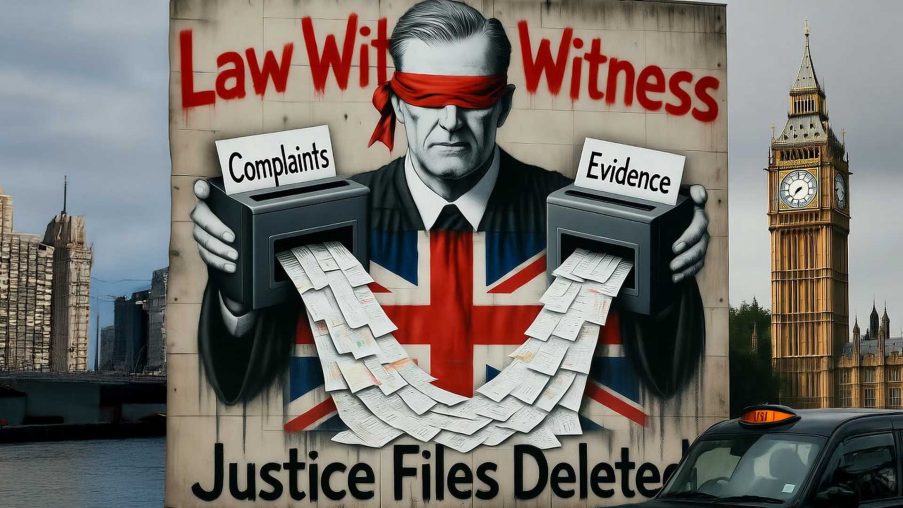When the Government’s most senior lawyer, Sir Jonathan Jones KC, resigned in September 2020 over the Johnson Government’s plan to breach international law, it was presented as an act of conscience.
Yet newly surfaced correspondence suggests another story—one that exposes a deep structural flaw at the very heart of British legal governance: a total absence of an auditable complaint process within the Attorney General’s Office (AGO) and the Government Legal Department (GLD).
An email dated 17 August 2020, sent from the Treasury Solicitor’s own address, acknowledged receipt of a complaint about serious misconduct—but without any case reference, investigation number, or audit trail. Less than four weeks later, Jones resigned.
No case file.
No traceability.
No accountability.
The Disappearing Complaint
The 17 August 2020 email, sent under the GLD banner, was supposedly the AGO’s response to a formal complaint concerning conduct within the Government Legal Department.
But the reply came from the very office under scrutiny—the Treasury Solicitor’s—without an identifiable AGO complaints protocol or reference number.
The allegations, which should have triggered an independent review, were instead reframed as “private disputes” and diverted to other agencies. No internal case number, no cross-department referral, and no sign of investigation follow-up.
In plain terms, the GLD answered a misconduct complaint about itself.

The chronology is significant. If the complaint remained “live” at the point of resignation, the absence of any recorded investigation or outcome would represent a systemic failure of public-sector accountability.
Without a case ID or audit log, there is no evidence the matter was ever opened, reviewed, or closed.
A Failure of Structure, Not Just Process
This episode reveals more than bureaucratic sloppiness. It demonstrates the complete lack of an auditable complaints architecture for the AGO and GLD—bodies that sit at the apex of the UK’s constitutional legal framework.
Unlike regulators or ombudsman services, neither the AGO nor the GLD publish a transparent process for logging and tracking complaints about their own officials. That means allegations of misconduct can be acknowledged, redirected, or quietly buried with no external oversight and no paper trail available for Parliamentary, judicial, or police review.
This is not a gap in procedure. It is a void in the rule-of-law infrastructure itself.
Conflict of Interest: “Marking His Own Homework”
The correspondence shows the response originated from within the Treasury Solicitor’s office—the very entity subject to the allegations.
In governance terms, this is the equivalent of an auditor signing off their own accounts.
Such self-review is incompatible with public-sector accountability. It undermines not only the credibility of the department but the public trust upon which the legal system depends.
As one observer who wishes to remain anonymous put it in correspondence:
“The priceless currency of Public, Parliamentary and Press trust upon which the Attorney General’s Office and Government Legal Department trade exclusively is being abused, by those in the highest offices.”
— Mr. R (Email to Legal Lens, 22 Oct 2025)
Why It Matters
These are not administrative technicalities. The AGO and GLD are the ultimate guardians of legal propriety inside government. If their complaint processes lack traceability, then the very system tasked with upholding legality is unmonitored and unaccountable.
Every citizen, litigant, and lawyer in Britain relies on the assumption that those at the top obey the standards they impose on everyone else. If the Treasury Solicitor can respond to a live complaint about his own department without independent oversight, the entire chain of legal trust collapses.
What Must Now Happen
To restore integrity, the following steps are essential:
- Publish Complaint Frameworks:
- Audit Confirmation:
- Separation of Functions:
- Transparency Statement:
Conclusion: The Unanswered Question
Why did the Government’s most senior lawyer resign during what appears to have been a live complaint handled within the Attorney General’s Office—yet publicly frame his exit as a matter of principle?
Was he pushed, or did he jump?
Was he protecting himself, the Department—or both?
And if the Treasury Solicitor’s office could respond to allegations about itself without record or oversight, what does that say about the rule of law at the very top of government?
These are not rhetorical questions. They go to the heart of whether the Attorney General’s Office and Government Legal Department can credibly police themselves.
If those entrusted with enforcing legality cannot demonstrate a verifiable audit trail, then no public institution in Britain can honestly claim to operate under the rule of law.
Until the AGO and GLD publish transparent complaint data—showing how allegations are logged, referenced, and resolved—the integrity of the UK’s legal governance remains in doubt.
Author
John Barwell
Founder & Principal Consultant, Legal Lens Independent Consultancy
Regulatory Accountability | Whistleblowing | Employment Law | Litigant Support
(This article draws upon verified correspondence and official records. It makes no finding of criminality and calls solely for transparency, auditability, and public accountability in the handling of serious complaints within government legal institutions.)

